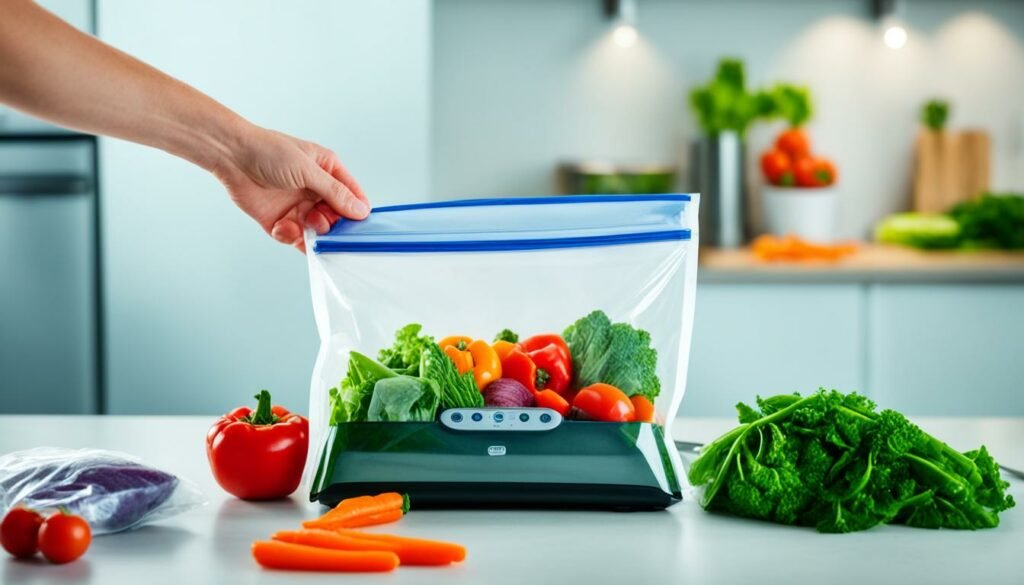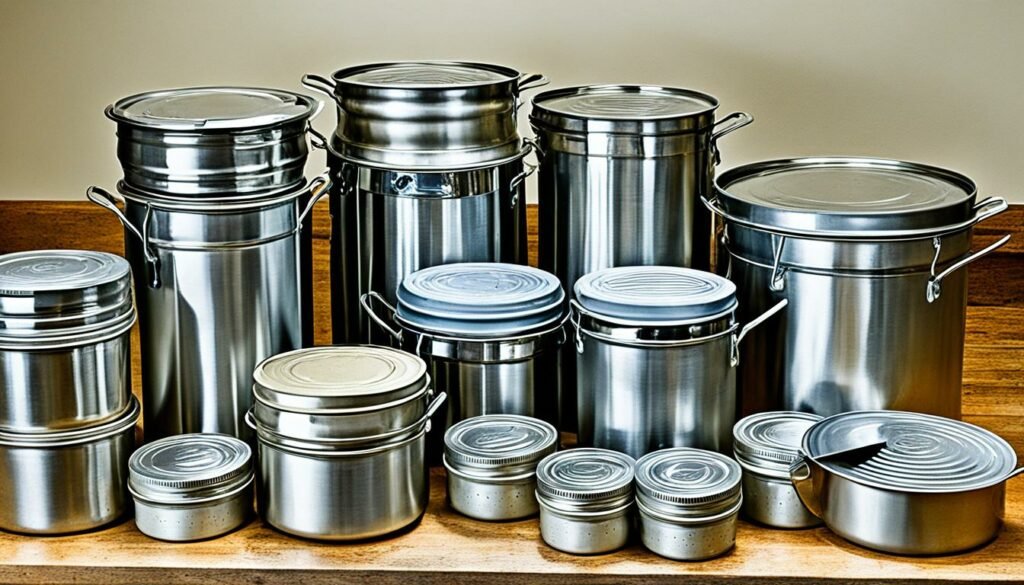I’ve always been intrigued by the art of food preservation. It’s a crucial skill for anyone who loves cooking or enjoys exploring new flavors. You might find yourself pondering the best approach to maintaining freshness. Two methods often surface in discussions: vacuum sealing and canning. Both are renowned for their ability to extend the life of food, but which reigns supreme?
This article aims to shed light on these two preservation techniques. We’ll scrutinize their effectiveness in lengthening the shelf life of food. By examining the advantages and disadvantages of each, we hope to guide you in selecting the most suitable method for your culinary endeavors. Let’s delve into the realm of food preservation and uncover which technique emerges as the top choice for your kitchen.
Understanding Food Preservation Techniques
Food preservation is a vital skill that has evolved significantly over time. It’s intriguing to see how we’ve transitioned from basic methods to advanced techniques for maintaining food freshness. Let’s delve into the realm of food preservation, exploring its significance, historical background, and contemporary approaches.
The Importance of Food Preservation
Preserving food is crucial for minimizing waste and prolonging shelf life. By employing advanced food preservation methods, we can enjoy seasonal produce throughout the year and save money by purchasing in bulk. This approach benefits both our wallets and the environment.
Historical Methods vs. Modern Approaches
Historical preservation techniques have been in use for centuries. Our ancestors utilized salting, smoking, and sun-drying to extend the life of food. These methods were effective but often altered the food’s taste and texture.
Today, we have modern food storage options that offer greater convenience and superior results. Techniques like refrigeration, freezing, and vacuum sealing have improved food preservation. These methods help preserve the original flavor and nutritional content of our food.
Basic Principles of Vacuum Sealing and Canning
Two prevalent preservation techniques are vacuum sealing and canning. Vacuum sealing eliminates air from containers, which prevents oxidation and bacterial growth. Canning employs heat processing to kill microorganisms and create a secure seal. Both methods aim to maintain food freshness and safety for consumption over longer periods.
| Method | Principle | Best For |
|---|---|---|
| Vacuum Sealing | Air removal | Dry goods, meats, cheese |
| Canning | Heat processing | Fruits, vegetables, sauces |
Understanding these preservation techniques aids in selecting the appropriate method for various foods and storage requirements. Whether you lean towards traditional or modern methods, food preservation is a valuable skill for every household.
Vacuum Sealing: A Modern Approach to Food Storage

Vacuum sealing has transformed food storage in recent years. It provides a practical way to keep various foods fresh. By removing oxygen, it extends the shelf life of perishables significantly.
This method preserves the original taste, shape, and nutrients of food. Whether storing meats, vegetables, or dry goods, it keeps them fresh for longer. However, it’s essential to note that vacuum-sealed foods still require refrigeration or freezing for best results.
The process is quick and simple, eliminating the need for chemicals. Vacuum sealers are suitable for both home and commercial use, offering an efficient way to save space and preserve food.
| Food Type | Shelf Life (Regular Storage) | Shelf Life (Vacuum Sealed) |
|---|---|---|
| Ground Beef | 1-2 days | 1-2 years |
| Vegetables | 1-2 weeks | 2-3 years |
| Cheese | 1-2 weeks | 4-8 months |
| Cereal | 1-2 months | 1-2 years |
The table shows the significant increase in shelf life with vacuum sealing over regular methods. This technique has revolutionized my food preservation, making it crucial in my kitchen.
Canning: The Time-Tested Preservation Method
Canning has been a cornerstone of food preservation for ages. It’s a method I’ve found to be incredibly effective for storing seasonal produce and making meals all year. Let’s delve into the world of canning, exploring its various facets.
Dry Canning vs. Heat Canning
There are two primary canning methods: dry and heat. Dry canning suits items like rice, beans, and flour. Heat canning, however, excels with fruits, vegetables, and meats. I opt for heat canning for its broad food compatibility and effectiveness in preserving a multitude of foods.
The Science Behind Canning
At the core of canning lies heat processing. This involves subjecting food to high temperatures, which eradicates harmful microorganisms and seals the jar in a vacuum. Such a process guarantees the food remains safe and fresh for a long time. When selecting canning supplies, it’s essential to pick the right jars, lids, and canners, whether pressure or water bath.

Types of Foods Suitable for Canning
I relish the creativity that comes with canning various recipes. Here’s a compilation of foods that are ideal for canning:
- Fruits: peaches, berries, apples
- Vegetables: tomatoes, green beans, carrots
- Meats: chicken, beef, fish
- Jams and jellies
- Pickles and relishes
| Food Type | Processing Method | Shelf Life |
|---|---|---|
| High-acid fruits | Water bath canning | 12-18 months |
| Low-acid vegetables | Pressure canning | 2-5 years |
| Meats | Pressure canning | 2-5 years |
With the correct canning supplies and recipes, you can safely preserve a wide array of foods. This ensures you can enjoy them all year. It’s vital to adhere to proven canning recipes and heat processing methods for food safety and quality.
Vacuum Sealing vs. Canning: A Comprehensive Comparison
Choosing between vacuum sealing and canning can be a daunting task. Let’s delve into the specifics of each method to guide your decision-making process.
Shelf Life and Food Safety
Canning stands out for its extended shelf life, keeping food safe for 1-5 years. In contrast, vacuum sealing offers a 1-3 year shelf life. Both methods are committed to food safety, but canning’s heat treatment is more effective in eradicating harmful bacteria.
Nutrient Retention and Flavor Preservation
Vacuum sealing excels in preserving nutrients. It does so without the need for heat, ensuring vitamins and minerals remain intact. Additionally, the sealed environment helps maintain the food’s original flavors, outperforming canning which can alter taste due to high temperatures.
Cost-Effectiveness and Initial Investment
Canning is more budget-friendly at the outset. You only need jars, lids, and a large pot to begin. On the other hand, vacuum sealing requires a specialized machine, increasing the initial cost. While vacuum bags can accumulate over time, canning jars are reusable, offering a more balanced long-term financial perspective.
Convenience and Ease of Use
Vacuum sealing is notably quicker and easier to use. It involves a straightforward seal-and-store process. In contrast, canning requires more time and effort, necessitating precise temperature control and specific processing times. Nevertheless, canned goods are easier to store, not requiring refrigeration until opened.
| Feature | Vacuum Sealing | Canning |
|---|---|---|
| Shelf Life | 1-3 years | 1-5 years |
| Nutrient Retention | High | Moderate |
| Initial Cost | Higher | Lower |
| Ease of Use | Very Easy | Moderate |
Choosing the Right Method for Your Needs
When selecting home food storage methods, I meticulously evaluate my options. The decision between vacuum sealing and canning hinges on several key factors. Initially, I assess the type of food I aim to preserve. For instance, meats and vegetables intended for consumption within a few months, vacuum sealing is my preferred choice. It ensures the retention of flavors and maintains the texture of the food.
For preserving fruits and prepared dishes over extended periods, canning is my preferred method. It’s ideal for items intended for storage without refrigeration. The size of my kitchen also influences my decision. Vacuum sealing is more space-efficient, which is crucial for my compact kitchen setup.
Time efficiency is another critical consideration. Vacuum sealing is swift and straightforward, making it suitable for hectic schedules. Conversely, canning demands more time and effort but guarantees a longer shelf life. Additionally, I consider the financial implications. Although vacuum sealers come with an upfront cost, they can significantly reduce food waste expenses over time.
- Food type and desired shelf life
- Available storage space
- Time and effort required
- Initial investment and long-term savings
By thoughtfully weighing these factors, I can select the most suitable food preservation method for my home. Whether I choose vacuum sealing or canning, both techniques are effective and economical in preserving food.
Conclusion
I’ve delved into the realm of food preservation, contrasting vacuum sealing and canning. Each method brings distinct advantages for extending food freshness and safety. Vacuum sealing excels in preserving food quality, ideal for short-term storage. Conversely, canning ensures a long shelf life without refrigeration.
Choosing a preservation method requires a keen understanding of your needs. Consider the food types, storage duration, and available space. Many households benefit from employing both vacuum sealing and canning for flexibility in their food preservation.
My experience shows that integrating vacuum sealing and canning revolutionizes food preservation. This combination offers a broader range of options and reduces food waste. It’s particularly beneficial for busy individuals, meal prep enthusiasts, or anyone aiming to extend their groceries’ shelf life.
The ideal food preservation approach depends on your specific circumstances. By grasping the unique strengths of each method, you can make educated decisions. These choices ensure your food remains fresh, tasty, and safe for extended periods. Happy preserving!
FAQ
What is the main difference between vacuum sealing and canning?
Vacuum sealing removes air to extend shelf life, whereas canning uses heat to kill bacteria. Vacuum-sealed foods need refrigeration or freezing. In contrast, canned foods can sit at room temperature.
Which method preserves nutrients and original flavors better?
Vacuum sealing is superior at preserving nutrients and flavors. Canning can change textures and flavors due to high heat.
How do the shelf lives of vacuum-sealed and canned foods compare?
Canned foods can last 1-5 years, while vacuum-sealed foods typically last 1-3 years. This difference is more pronounced when considering storage without refrigeration.
Which method is more cost-effective in the long run?
Canning is cheaper upfront but requires more time. Vacuum sealing costs more initially but is faster and easier.
Are there any food safety considerations for these methods?
Yes, both methods have food safety concerns. Canning demands strict guidelines to avoid botulism. Vacuum-sealed foods must be kept refrigerated or frozen to prevent spoilage.
Which method is better for preserving different food types?
Canning is versatile for preserving a broad range of foods, including fruits, vegetables, meats, and prepared dishes. Vacuum sealing suits meats, vegetables, and dry goods for short-term storage.
How do I choose between vacuum sealing and canning for my household?
Think about the types of food, desired shelf life, storage space, nutritional needs, and time availability. Many households use both methods to enhance preservation and reduce food waste.
